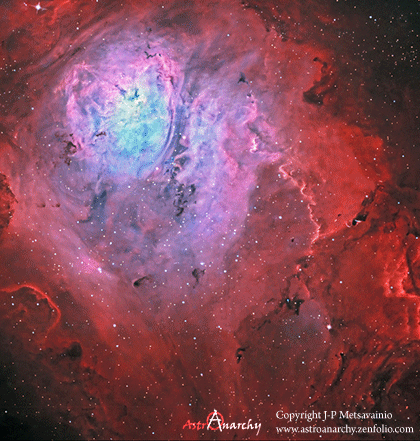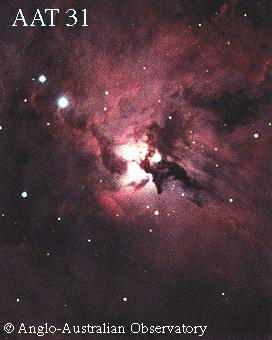This is a very beautiful picture of a much-photographed object.
I checked out the imaging data of the picture and was a bit confused. As far as I could understand, today's APOD is not an RGB image, photographed through red, green and blue filters. It is also not an image which has been enhanced with extra Ha data. I would assume, therefore, that this is an image whose colors do not depend on filters. Clearly it is not a mapped color image, either. The colors in this image are unusually delicate.
The Lagoon Nebula shows a progression of star formation going from left to right. Clearly the youngest object here is the star illuminating the Hourglass Nebula, the small bright whitish object at center right. To the left of the Hourglass Nebula is a bright blue star, 9 Sagittarius, the brightest star inside the Lagoon Nebula. (The bright yellow-white star at two o'clock is a foreground object.) Blue 9 Sagittarius is a very hot and bright O-type star. Today's APOD shows that 9 Sgr interacts with the gas and dust in the Lagoon Nebula: there is a suggestion of a cavity around the star, and the dust in its vicinity has a bluish tinge. This probably means that the star is in the process of blowing the gas and dust away from itself with its strong stellar wind, but there is still dust not too far from it. This dust faintly reflects the star's blue light, creating a faint blue reflection nebula mixed with the larger nebula's overall red Ha light. 9 Sagittarius appears to be at a similar evolutionary stage as
S Monocerotis.
To me, the long curving dust lane that gives the Lagoon Nebula its name can be thought of as partly created by 9 Sagittarius. But there are bright stars on the other side of that prominent dust lane, too. There is a slight similarity between this dust lane dividing groups of bright stars in the Lagoon Nebula and the dust lane dividing groups of bright stars in
IC 1805.
The group of stars on the other side of the dust lane in the Lagoon Nebula belong to cluster NGC 6530. These stars don't seem to interact with the nebulosity of the Lagoon Nebula in the same way as 9 Sagittarius, although the curving red ridge below the cluster may have something to do with these stars. At least some of that red ridge may have been created by 9 Sagittarius and the star in the Hourglass Nebula, however. There is a light-colored "extension downward" of the dark dust lane of the Lagoon Nebula, and this light-colored extension may well have been created by 9 Sagittarius but not by cluster NGC 6530. In other words: the stars of NGC 6530 are older than 9 Sagittarius, and 9 Sagittarius is older than the star in the Hourglass Nebula.
We are watching star formation in progress.
Ann
 M8: The Lagoon Nebula
M8: The Lagoon Nebula
